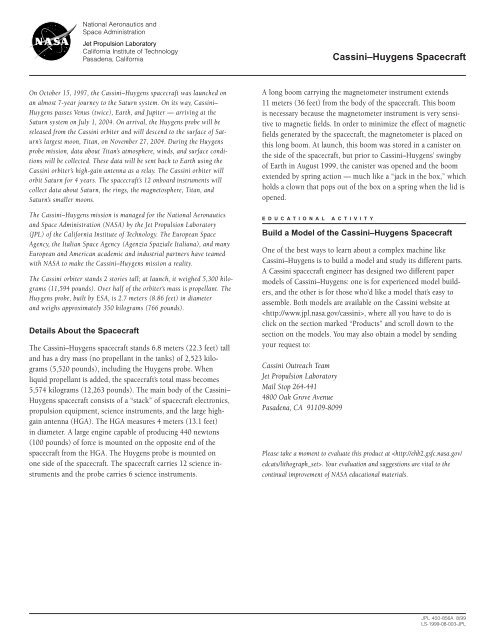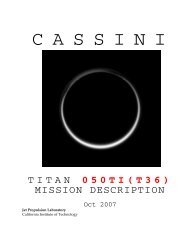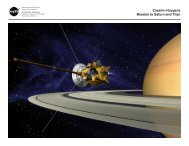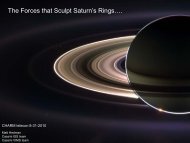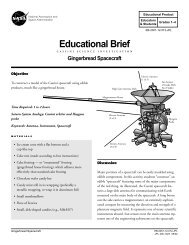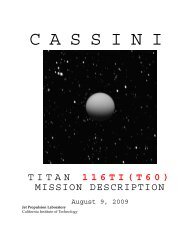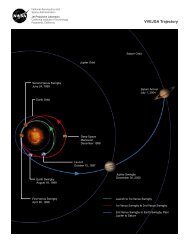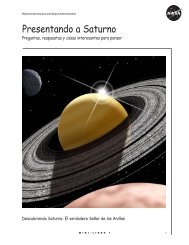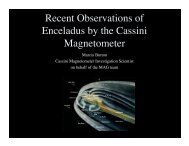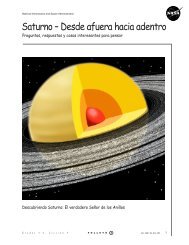CassiniâHuygens Spacecraft - Cassini - NASA
CassiniâHuygens Spacecraft - Cassini - NASA
CassiniâHuygens Spacecraft - Cassini - NASA
- No tags were found...
Create successful ePaper yourself
Turn your PDF publications into a flip-book with our unique Google optimized e-Paper software.
National Aeronautics andSpace AdministrationJet Propulsion LaboratoryCalifornia Institute of TechnologyPasadena, California<strong>Cassini</strong>–Huygens <strong>Spacecraft</strong>On October 15, 1997, the <strong>Cassini</strong>–Huygens spacecraft was launched onan almost 7-year journey to the Saturn system. On its way, <strong>Cassini</strong>–Huygens passes Venus (twice), Earth, and Jupiter — arriving at theSaturn system on July 1, 2004. On arrival, the Huygens probe will bereleased from the <strong>Cassini</strong> orbiter and will descend to the surface of Saturn’slargest moon, Titan, on November 27, 2004. During the Huygensprobe mission, data about Titan’s atmosphere, winds, and surface conditionswill be collected. These data will be sent back to Earth using the<strong>Cassini</strong> orbiter’s high-gain antenna as a relay. The <strong>Cassini</strong> orbiter willorbit Saturn for 4 years. The spacecraft’s 12 onboard instruments willcollect data about Saturn, the rings, the magnetosphere, Titan, andSaturn’s smaller moons.The <strong>Cassini</strong>–Huygens mission is managed for the National Aeronauticsand Space Administration (<strong>NASA</strong>) by the Jet Propulsion Laboratory(JPL) of the California Institute of Technology. The European SpaceAgency, the Italian Space Agency (Agenzia Spaziale Italiana), and manyEuropean and American academic and industrial partners have teamedwith <strong>NASA</strong> to make the <strong>Cassini</strong>–Huygens mission a reality.The <strong>Cassini</strong> orbiter stands 2 stories tall; at launch, it weighed 5,300 kilograms(11,594 pounds). Over half of the orbiter’s mass is propellant. TheHuygens probe, built by ESA, is 2.7 meters (8.86 feet) in diameterand weighs approximately 350 kilograms (766 pounds).Details About the <strong>Spacecraft</strong>The <strong>Cassini</strong>–Huygens spacecraft stands 6.8 meters (22.3 feet) talland has a dry mass (no propellant in the tanks) of 2,523 kilograms(5,520 pounds), including the Huygens probe. Whenliquid propellant is added, the spacecraft’s total mass becomes5,574 kilograms (12,263 pounds). The main body of the <strong>Cassini</strong>–Huygens spacecraft consists of a “stack” of spacecraft electronics,propulsion equipment, science instruments, and the large highgainantenna (HGA). The HGA measures 4 meters (13.1 feet)in diameter. A large engine capable of producing 440 newtons(100 pounds) of force is mounted on the opposite end of thespacecraft from the HGA. The Huygens probe is mounted onone side of the spacecraft. The spacecraft carries 12 science instrumentsand the probe carries 6 science instruments.A long boom carrying the magnetometer instrument extends11 meters (36 feet) from the body of the spacecraft. This boomis necessary because the magnetometer instrument is very sensitiveto magnetic fields. In order to minimize the effect of magneticfields generated by the spacecraft, the magnetometer is placed onthis long boom. At launch, this boom was stored in a canister onthe side of the spacecraft, but prior to <strong>Cassini</strong>–Huygens’ swingbyof Earth in August 1999, the canister was opened and the boomextended by spring action — much like a “jack in the box,” whichholds a clown that pops out of the box on a spring when the lid isopened.E D U C A T I O N A L I A C T I V I T YBuild a Model of the <strong>Cassini</strong>–Huygens <strong>Spacecraft</strong>One of the best ways to learn about a complex machine like<strong>Cassini</strong>–Huygens is to build a model and study its different parts.A <strong>Cassini</strong> spacecraft engineer has designed two different papermodels of <strong>Cassini</strong>–Huygens: one is for experienced model builders,and the other is for those who’d like a model that’s easy toassemble. Both models are available on the <strong>Cassini</strong> website at, where all you have to do isclick on the section marked “Products” and scroll down to thesection on the models. You may also obtain a model by sendingyour request to:<strong>Cassini</strong> Outreach TeamJet Propulsion LaboratoryMail Stop 264-4414800 Oak Grove AvenuePasadena, CA 91109-8099Please take a moment to evaluate this product at . Your evaluation and suggestions are vital to thecontinual improvement of <strong>NASA</strong> educational materials.JPL 400-856A 8/99LS-1999-08-003-JPL


